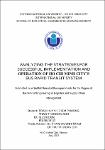| dc.description.abstract | Public transportation plays a significant role in the lives of human societies,
influencing essential factors such as economic, social, cultural, and environmental
aspects of the community. The bus rapid transit (BRT) system, a form of public
transportation, takes part of the traffic solution in urban transportation networks. The
process of selecting and ranking appropriate strategies to address the challenges and
obstacles for the effective operation and implementation of the bus rapid transit
(BRT) system is a significant requirement. Recent research has widely discussed the
issue, but such assessments have remained limited in Viet Nam, Ho Chi Minh city
where there are many challenges in improving the traffic solution and analyzing the
direction of proposal for the implementation of BRT system in Vo Van Kiet - Mai
Chi Tho boulevards. As a result, to facilitate the assessment process, this study
addresses the research gap by identifying the most significant obstacles to the
implementation and operation of the BRT system. Additionally, it recommends the
most effective approach to overcoming these challenges. To tackle this problem,
simulation with Arena 14 represented an realistic system operation of Bus 39 and Bus
D4, then a BRT optimization model with OptQuest for Arena software has been
created to minimize multiple objectives including total of passenger waiting time and
vehicle energy consumption. Firstly, the study simulated reality scenarios using
Arena 14 software, and analysis of variable by adjusting buses to the current bus
system of Bus 39 and Bus D4, as well as accelerating the BRT buses, are then
constructed to solve the multiple objectives. Additionally, these scenarios areii
evaluated and ranked with Multiple criteria decison-making (MCDM) integrating
Fuzzy and AHP. Finally, the most effective approach is compared to the results
obtained from the optimization of each response variable on a unified BRT line. The
results indicate the suggested approach ensuring the BRT system is executed and
operated successfully enough to tackle real-life issues. The methodology presented
in this study can be highly beneficial in aiding public transportation operators to
effectively establish and manage a Bus Rapid Transit (BRT) system | en_US |


